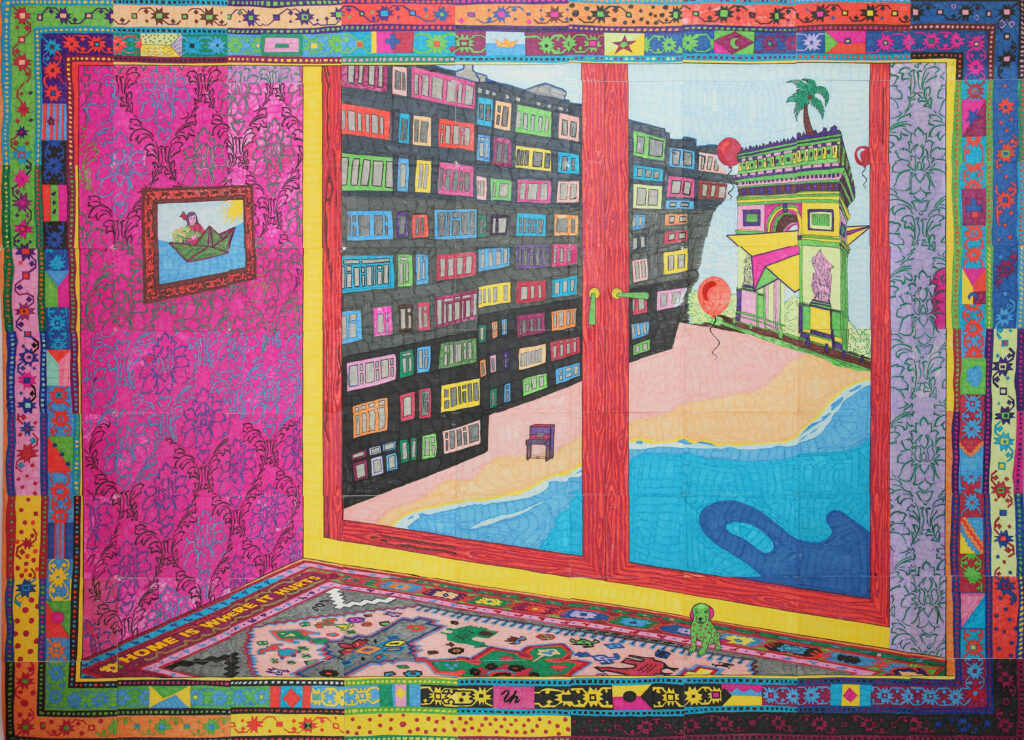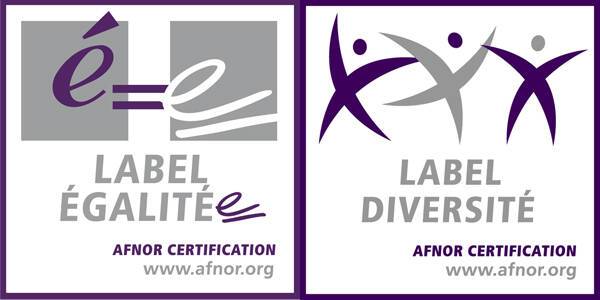
ARAKS SAHAKYAN
TRANSITS
Olive trees, orange and palm trees, cocktails by the sea, airplanes and boats, a room with a view, multicolored oriental carpets and blue skies… For her solo exhibition at the Ygrec-ENSAPC art center in Aubervilliers, Araks Sahakyan offers us an immediate boarding pass for a journey across the globe. In the East as well as in the West, we follow the elements of her narrative step by step. Entitled TRANSITS, the exhibition essentially offers dozens of openings, like so many windows on a world in perpetual movement.
At first glance, these brightly colored drawings, which occupy a large part of the space’s windows, look like postcards or tourist brochures. They are apparently idyllic panoramas that turn out to be tragic when you look closer. Because if the change of scenery is assured, joy and relaxation are less accessible. The journey will undoubtedly be more disturbing than expected.
Based on the principle of a fragmented tapestry, puzzle or patchwork, these drawings are composed of dozens of A4 sheets on which the artist has gathered snippets of her personal memory, which itself has been punctuated by multiple voyages. From her childhood in the heart of the Caucasus, in her native Armenia, a country of the former Soviet Union known as the cradle of Christianity, to her adopted country, France, via Spain where she lived her adolescence with her parents who emigrated there, Araks Sahakyan retains a few images that she mixes with a collective memory made up of Greco-Roman mythology, biblical stories and art history.
With the current geopolitical realities, a new, more dramatic layer is superimposed on these images. For example, “Floating Carpet” has nothing to do with a flying carpet from the Arabian Nights: it plunges us straight into the seascapes of the Mediterranean where jellyfish, Kalashnikovs, drones and floating bodies meet for better or for worse. They reflect the imagination of the artist who, obviously, alludes to those people known as “migrants” for whom the Mediterranean is more like a marine coffin than a holiday resort. Its crossing is not easy while many wars are being fought around its shores. In another drawing entitled “The Sons of Abraham”, the large black eyes of the Fayum portraits dating from the first centuries of our era border the composition of an oriental carpet where the muscularity of a character in distress extracted from Géricault’s “Raft of the Medusa” (1819) is added to the vision of a wheeled suitcase in which a stowaway has hidden. In a childish, voluntarily naive and joyful way, Araks Sahakyan alludes to the countries of the Middle East – most of which are in conflict – from which the sons of Abraham came, who are themselves at the origin of the three monotheistic religions that are Judaism, Christianity and Islam. Beyond the fate of the so-called “migrants”, Araks Sahakyan keeps a visual diary and thus addresses the global epidemic of coronavirus through a drawing reminiscent of Chinese imperial art, where a sinuous multicolored pangolin appears. “We can’t escape it” can be read as a slogan or a threat. Elsewhere, in the center of a series of windows reminiscent of Gaudi’s architecture, it is the artist’s father who is represented as he has just emigrated to Spain and is engaged in the work of picking fruit to support his family. A way to draw attention to the condition of immigrants, ready to take on low-wage work in order to survive at any cost.
Fragmented on several sheets, these drawings are mostly “Paper Carpets”. They can be stored – not in suitcases – but in bound boxes. Easily folded and transportable, they remind us that it can always be a question of taking off to an unknown destination.
Some of these colored works with felt, whose traces of color remind us of the regularity of needlework, end up being really transformed into carpets whose manufacture is entrusted to Armenian craftsmen. They weave them manually, with a needle, according to methods transmitted from generation to generation for centuries. This is the case of “Las ventanas de mi casa” (The windows of my house) which presents a view of the Arc de Triomphe transposed to the seaside. These are the views of three cities that she has traveled through and that have fed her imagination: the view of the volcanic stone buildings of Hrazdan, her hometown in Armenia, the view of the beach in Alicante, Spain, and finally Paris. The artist puts partially in abyss a fantasized vision of the window of her last studio, avenue Mac-Mahon in Paris. On the floor, a carpet in the carpet reminds us of her native land, Armenia, located on the historic Silk Road, where most of the oriental carpets originate. The artist sees in each of these woven pieces a territory with its own history, its surface and its borders.
It is in this geographical logic that the artist has also created a series of very particular flags that remind us of her interest in abstract motifs. These oils on wood list, as in a Pantone color chart, some of the different skin tones that can exist throughout the world. Whether it is France, Norway or the United States, these flags without borders are barely recognizable in these colors resembling earth-tones, and inspired by our thousand and one skin colors. The blood red, the only bright hue that this colorist-at-heart allowed herself to reveal in this exercise, underlines the multiculturalist spirit of this work.
Hijacking ancient symbols and mythologies as well as craft techniques in a resolutely pop work, Sahakyan puts memory and transmission at the center of her work and resonates perfectly with an era where identity, migratory flows, borders and languages have become problematic. The display windows of the Ygrec-ENSAPC art center, a place of passing through, send an ideal invitation to passers-by: that of movement through displacement, travel and other transits. Then, the destination does not matter.
Anaïd Demir
Traduit par David Malek
ARAKS SAHAKYAN
Araks Sahakyan is a visual artist and performer. Graduated from the École nationale supérieure des arts de Paris-Cergy (ENSAPC) in 2018, after spending a year at Central Saint Martins in London. Exhibited during the Jeune Création Video Program in 2020, she was selected for the 65th edition of the Salon de Montrouge and winner of the Drawing Factory Residency in Paris in 2021.
A Spanish-Armenian artist who works between several languages, she makes translation the central process of a transdisciplinary work where drawing, video and performance are mingled and intertwine. She plays with the boundaries between reality and fiction, and deploys a work where geopolitical and aesthetic issues related to displacement and identity intersect.
This project is the 2020 winner of the Fonds Régional pour les talents émergents (FoRTE), financed by the Île-de-France Region.








